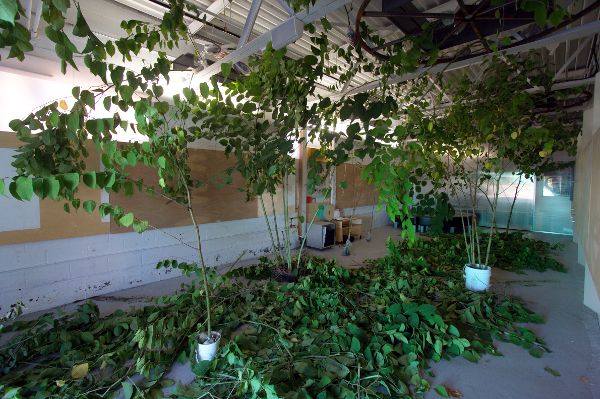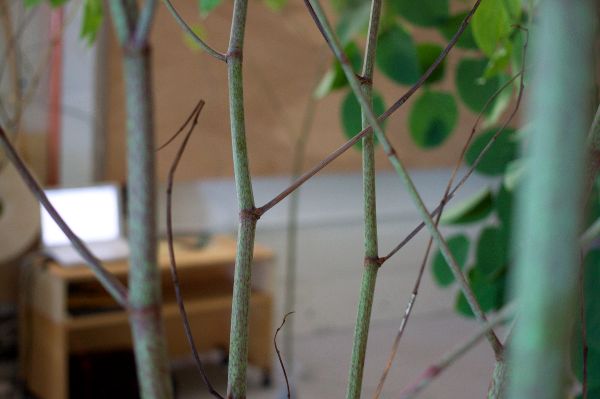
This Friday, March 14th, Mind Matters opens at UCSF’s Sandler Neuroscience Center on the Mission Bay campus. I’ll be there from 2 to 5pm with my collaborator, Gautam Agarwal, a neuroscientist at UC Berkeley. Our work, Spatializing Waves, is an installation that includes two large prints and several videos. The title refers to both Agarwal’s work making connections between brainwaves and spatial understanding, and our own work examining and creating material waves that are related to brain activity.
Spatializing Waves makes connections between electrical waves moving across the brain and other waves found in the material world. Waves in our world take on a variety of forms: they are periodic and chaotic; natural and artificial; borne of photons, molecules, cells, humans, and cars. The project examines how similar phenomena are found at vastly different scales arising from unique mechanisms, making speculative links between our own brain activity and the rhythms of the world.
Then on Saturday, Land and Sea will be releasing a new book entitled OVERVIEW, full of 79 Risograph artist prints at Et Al in San Francisco. Included in this beautiful object is collaborative print I made with Katie Hargrave. Stop in between 6 and 9pm to check it out:

(No Comments)

Recently I have been working with Gautam Agarwal, a neuroscientist at UC Berkeley, on a piece for the Mind Matters show next Spring at UCSF. His work is focused on understanding the relationship between spatial awareness and neural activity. He has been teaching me about his research and I have been developing data visualization tools in Processing to view and navigate through the massive data sets he is using:

OpenGL in Processing has allowed us to visualize hundred of thousands of data points, animate them, rotate them in three dimensions, and change parameters in real time. In the visualization below, color represents spatial positioning and the height of the curves represent neural activity, showing clear connections between the two variables:

We don’t yet have a vision of what this all becomes for the show, but we are developing a large cache of materials to work with.
—
Last Spring, avatar internet artist LaTurbo Avedon visited my Internet Tools class at SFAI. It was certainly the most unorthodox guest speaker I’ve had visit a class. Check out her intro video and then check out her projects, both of which are great.
(No Comments)
![Imagine and Manifest the Impossible [Achievable] Dream [Goal], screenprint on paper](http://www.nicklally.com/wp-content/uploads/2013/09/IMG_1374.jpg)
Imagine and Manifest the Impossible [Achievable] Dream [Goal], screenprint on paper
is happening this weekend (Friday 9/20 through Sunday 9/22) and I will have a couple things floating around. Pictured above is a motivational poster made in collaboration with
Katie Hargrave that will be at the
ACRE /
Bad At Sports booth.
Katie, Dan Leudtke, and I will also have stories and drawings from our Location to Station project in the EXPO Register, a daily info/gossip/etc newspaper put together by Dana Bassett.
(No Comments)

I’m going to start up Hacking for Artists again with weekly workshops on Wednesday nights at my studio in Oakland. They are focused on artists who want to learn how to incorporate electronics and/or computer programming into their practices. They are not formal classes, but open time to work on projects in adjacency to and in collaboration with other artists who are figuring things out. And I am around the whole time to help you out, provide you with resources, and point you in the right direction. I have started to build an electronics lab and have all the basic tools (soldering iron, breadboards, etc) you will need along with a lot of components (arduino, raspberry pi, resistors, caps, lights, sensors, etc, etc) to play with.
I think they work best if you have a project and/or idea in mind and come to the workshop with questions. Then I can put together little demos, show you tutorials online and in books, and help you figure things out. I’m also open to feedback, so please let me know what you would like to see.
If you are interested in programming, I will give you a couple pre-workshop assignments to get started, then we’ll go from there.
So if you would like to participate, let me know. Since I’ll have to limit the number of people who show up, please RSVP to: nicklally *[AT]* gmail *[dot]* com
So here are some initial dates to think about:
September 18
September 25
October 2
October 9
October 16
…the future TBA
Let me know if you’ll be joining us!
(No Comments)

I’m in show opening tomorrow at Martina }{ Johnston in Berkeley:
Four Core Chambers
Curated by Katie Anania
Leah DeVun, Leslie Dreyer, Yasmin Golan, Nick Lally, David X. Levine, Sanaz Mazinani, Christina McPhee, Jeanne Stern, Elizabeth Travelslight, Andrew Voogel,Jungshih Wang, and Keith Wilson.
Saturday, September 7th, 2013 to Sunday November 3rd, 2013
Opening Reception: Saturday, September 7, 2013 from 4 – 8 p.m.
Hours: Sundays 1 to 4 p.m. or by appointment.
Cor Humanum: Four Artists on Matters of the Heart:
Thursday, October 10, 2013 from 6 – 9 p.m.
Closing Reception including a screening of Open Heart:
Sunday, November 3, 2013, 1 – 4 p.m.
Martina }{ Johnston is pleased to announce Four Core Chambers, a group exhibition of fourteen new works that explore the contours of the human heart, both romantically and medically. The artists involved are all based in the United States, and together their works map the gallery itself as an analog of the human heart, with the gallery’s central “chambers” helping to shape the flow of viewers’ experiences.
It’s co-sponsored by EMERGENCY-USA, an independent nonprofit organization that provides support for medical care, rehabilitation and relief efforts for the victims of wars, land mines, poverty and natural disasters around the world. They are doing amazing work.
My piece looks something like this:
Nick Lally’s video work Throb (2013) uses Euler Magnification algorithms to process film and news footage, and reveals people’s pulses hidden within the video information. The footage cuts between the original videos, processed videos, and stylized animations to reveal unexpected data within the visual elements. This, in turn, invites viewers to re-consider their own heartbeat not as the “original” to which the heartbeat reading is a “copy”, but as a highly relational and contingent piece of information in its own right.
More information.
(No Comments)

Michael Huggins and I recently completed an installation at zero station in Portland, ME. It will be up all month, although scaled-back. Here are some photos and video of the work in its full form:



The wall text reads:
knot talk
installation
michael huggins and nick lally
2013
The two artists have filled the gallery with Japanese Knotweed, a fast growing invasive weed harvested from the surrounding area. The plants, together with visitors’ bodies, modulate a complex sound installation as electric signals connect the plants, humans, and electronics. Did you know that plants communicate with each other using sound waves? Come in and talk to to some plants that are taking over the northeast.
To modulate the soundscape, gently grasp a plant’s stalk and hold on!
And for the geeks: we wired the plants to work as capacitive sensors using two Arduinos which talked to a PureData patch running in Debian Linux.
(No Comments)






![Imagine and Manifest the Impossible [Achievable] Dream [Goal], screenprint on paper](http://www.nicklally.com/wp-content/uploads/2013/09/IMG_1374.jpg)






